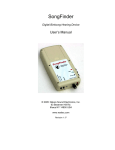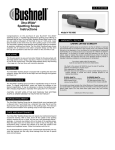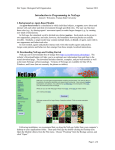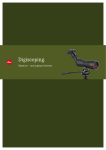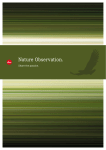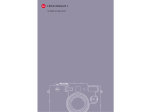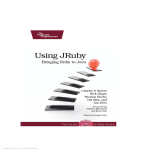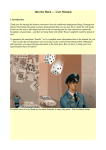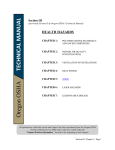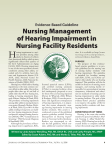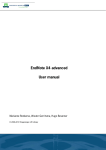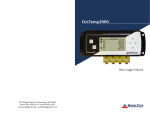Download to a PDF version of the SongFinder User`s Manual
Transcript
SongFinder Digital Birdsong Hearing Device User’s Manual © 2010 Nature Sound Electronics, Inc. 63 Besemer Hill Rd. Ithaca NY 14850 USA www.nselec.com Revision 2.0 2 – SongFinder User’s Manual Overview The SongFinder is an advanced digital device built for bird enthusiasts who suffer from high frequency hearing loss and who are unable to hear high-pitched bird songs in their natural surroundings. Unlike conventional amplifying-type hearing aids, the SongFinder works by lowering the frequency or pitch of bird songs into a range where the user has normal hearing. This method avoids the many pitfalls of extreme amplification. Furthermore, the SongFinder is a two-channel “binaural” device that allows the user to determine the directions and distances of singing birds. The SongFinder offers an elegant and tasteful solution for aging birders and other nature lovers who can no longer hear high singing birds. The Problem As we grow older, we experience diminished sensitivity to high frequency sounds. Youthful hearing extends as high as 20,000 Hz (Hz = cycles/second). However, the average person (especially among men) over fifty years of age has completely lost the very highest frequencies and often suffers moderate hearing loss in the range from 4,000 to 10,000 Hz. Moderate to severe hearing loss above 4,000 or 5,000 Hz becomes the norm for individuals living sixty and beyond. Loss of hearing with age, technically referred to as presbycusis, is a widespread phenomenon that seemingly cannot be avoided. To make matters worse, prolonged exposure to loud music and other loud background sounds also results in reduced sensitivity in the high range. This is NOT good news for aging birdwatchers! The average frequency of the songs of songbirds is about 4,000 Hz, approximately the same pitch as the highest note of a piano. Many warblers, sparrows, waxwings, kinglets, and a number of other birds produce sounds that reach 8,000 Hz and higher. Moderate to severe hearing loss in the 3,000 – 10,000 Hz range greatly reduces the ability of a birder to be aware of the presence of these high-pitched singers. The Traditional Solution: Amplification Aids The traditional approach to counteracting hearing loss has been to utilize amplifying hearing aids that raise the amplitude of incoming signals to levels where they can be heard. This approach works well in the realm of speech perception (mostly below 3000 Hz) but has limited application for birders and other nature lovers who are deaf to high-pitched bird songs but who have little trouble hearing speech. For aging birders, conventional amplifying-type hearing aids are usually a disappointment. Some of the problems encountered with such devices are summarized as follows: 1) There is a limit to how much a hearing aid can amplify before feedback squeal occurs. If hearing loss is severe, maximum amplification will not be adequate to allow high bird songs to be heard at reasonable distances in typical outdoor situations. 2) Conventional aids generally do not produce good amplification above 5,000 Hz. Thus, most amplifying hearing aids offer little or no help with the highest singing birds. In addition, recent clinical studies have suggested that amplifying high frequencies where hearing loss is severe can actually damage the ears. 3) Extraneous sounds such as wind noise or the sounds that accompany walking through leaves or stepping on twigs are also amplified and can be extremely annoying. Users often complain of “sensory overload” due to the continuous high-level amplification of such environmental sounds. 4) Even when users wear amplifying aids in both ears, the ability to determine distances and directions of incoming sounds is normally much reduced. The three dimensional or binaural aspect of hearing is lost and it becomes difficult, if not impossible, to find birds, even when they are heard. SongFinder User’s Manual – 3 The SongFinder: A Frequency Shifting Solution After 20 years of experimentation with a variety of devices, we have developed a digital instrument, the SongFinder, that is designed specifically for birders suffering from high frequency hearing loss, but who still have reasonably normal hearing in both ears up to around 2,000 – 2,500 Hz. As a reference point, if you have little trouble holding conversations with other people in a quiet room, then you probably have good hearing through 2,000 Hz. The SongFinder works on a frequency dividing principle. Incoming sounds above around 3,500 Hz are converted into digital signals that are acted upon by an internal digital signal processor (DSP) that performs mathematical transformations to accomplish frequency division. As a result, high bird sounds are lowered into a frequency range where one has normal or near-normal hearing. The user chooses the degree of lowering, reducing the frequency of incoming high-pitched sounds to one-half, one-third, or one-quarter. For example, a bird sound of 8,000 Hz will be perceived as 4,000 Hz when halved or 2,000 Hz when quartered. Using the SongFinder set to divide-by-four, a person with severe high frequency hearing loss will often be able to hear ALL the highest singing birds! The SongFinder responds only to high frequency sounds above around 3,500 Hz (the cutoff frequency is user adjustable). It is not based on an amplifying principle. Rather, the high-pitched sounds are lowered and then added, at normal amplitude or at slight to moderate amplification, to what one already hears. Since extreme amplification is never involved, extraneous sounds like the snapping of twigs do not become annoying. Sensory overload is avoided, feedback squeal does not occur, and the overall effect is gentle and natural. Because the SongFinder does not employ high amplification, it will not damage your ears. Furthermore, the unit is a two-channel “binaural” device that allows the user to determine the location of singing birds and insects. A small, loose-fitting binaural headset is worn which positions tiny microphones next to each ear. The two microphones pick up incoming high-pitched sounds and route them to the device that is stored in a shirt pocket or clipped on the belt. The two separate channels of high-pitched sounds are lowered and then fed back to each ear via miniature earphones. The earphones fit lightly on each ear and do not obstruct normal hearing (they do not plug the ear like many conventional hearing aids). The result is a lifelike, three-dimensional binaural perception that allows the user to judge directions and distances of incoming sounds with amazing accuracy. Such pitch lowered nature sounds are perceived as natural and real, and the user is able to determine the whereabouts of the sound makers in the outdoor environment. Is The SongFinder Right For You? The SongFinder is designed for those suffering from moderate to severe high frequency hearing loss in the higher ranges, but who still have reasonably good hearing up to around 2,000 – 2,500 Hz in both ears. Such individuals are almost completely deaf to high-pitched bird songs but will be able to hear human speech and low singing birds such as whip-poor-wills, robins, and cardinals without the need for special hearing aid devices. While the SongFinder is primarily a pitch-lowering device, it also offers the option of a moderate degree of amplification of the lowered signals. Potential buyers might first want to obtain an audiogram from an audiologist. Have the audiologist pay particular attention to high frequency response. Look for moderate to severe hearing loss above 3,000 – 4,000 Hz with normal or near-normal hearing up to around 2,000 Hz or beyond. If there is moderate loss at 2,000 Hz, the utility of the SongFinder will be somewhat reduced, although some people have used the SongFinder successfully in conjunction with amplification-type aids that provide additional boost in the low range. 4 – SongFinder User’s Manual Operating Instructions 1. Batteries The battery compartment is on the bottom of the unit and the cover slides off towards the rear. The SongFinder requires two AA-sized batteries. Use either standard 1.5-volt alkaline AA cells or else rechargeable 1.2-volt AA cells. When using rechargeable batteries, you may use either the older Nickel-Cadmium (NiCd) cells or else the newer Nickel-Metal-Hydride (NiMh) cells. The NiMh batteries provide longer run time than NiCd cells. Note: do not use the old style Carbon-Zinc batteries as they are prone to leakage! These batteries are often labeled “Classic” or “General Purpose.” Also, do not use 3-volt lithium camera batteries even though they may be the same size as an AA battery. When the batteries are almost exhausted, the SongFinder will continue to work but you may begin to hear crackling sounds as if there is an electronic short. This is a sign that the batteries need replacing. It is a good practice to always carry an extra set of batteries. Suggestions Concerning the Use of Rechargeable Batteries: When recharging NiCd or NiMh batteries be sure to use a charger designed for the type of battery being charged. NiCd and NiMh chargers are different and cannot be interchanged. Some newer chargers have a switch that selects between the two cell types and can be used with either. Also note that some chargers are designed for rapid charging (1 – 2 hours) and others for slow charging (12 – 16 hours). Be aware of this when purchasing a charger. When using a rapid charger make sure the cells you are charging are rated for rapid charging; some cells are not. Never attempt to recharge a non-rechargeable battery such as an alkaline cell. When using rechargeable batteries it is important to use two identical batteries as a set and keep those two batteries together. Cells of different types or different manufacturers or of different charge states will have different energy capacities. Differences in energy capacity between cell types will result in one of the cells becoming discharged before the other, which can damage that cell. The rule of thumb is to keep sets of rechargeable batteries together from the day they are purchased. SongFinder User’s Manual – 5 NiCd cells do not like to be partially discharged and recharged. They need to be fully discharged before recharging. If a NiCd cell is subjected to repeated shallow discharging/charging cycles it can develop a “memory” of this pattern and may be unable to be discharged beyond that point. NiMh cells do not exhibit this effect and can be safely recharged at any time. The best advice for either type of cell, however, is to use them until they are fully discharged and then fully charge them. It’s best to avoid overcharging either type of battery. Take them out of the charger when they are fully charged. As a final note, it is best not to leave the SongFinder power switch on for extended periods of time after the batteries have become totally discharged. This may damage the batteries and shorten their life. In some cases NiCd cells have been known to leak under these conditions. 2. Headset The headset cable terminates with three color-coded jacks. The red and green jacks are microphone inputs and the all-black jack is for the headphones. These should connected to the corresponding color-coded jacks found on the side of the SongFinder unit. The headset is worn on the head such that the plastic loop extends behind the head as shown. The braided cable should be on the left. The earphones should rest lightly on each ear, so as to minimize interference with normal hearing. The processing unit is small enough to fit in a shirt pocket (as illustrated on page 2 of this manual), but it may also be placed in a jacket or pants pocket. We suggest that the headset cable be routed under clothing to keep it from catching on branches or other obstacles. 6 – SongFinder User’s Manual 3. Front Panel Controls From right to left, the front panel includes the following controls: • On-Off Switch (turn unit on by pushing to the right) • LED Status Indicator (glows red when the unit is turned on) • Output Volume Control (turn clockwise to increase volume) • Balance Control (adjusts the relative volumes of the the right and left ouput channels) • Input Filter Setting (adjusts the high pass input filter – see #5 below for detailed explanation) • Divide-by Setting (user selectable; includes divide-by 2, 3, and 4) 4. Testing Your SongFinder Now is the time to test your SongFinder. Put the headphones on and make certain they are plugged-in correctly. For initial testing, choose the divide-by-2 setting, set the Input filter to “M”. Leave the balance control as-it-is, and turn the volume control to the midway point. Now turn on the power switch. The red light should come on. Make a psssss-psssss-psssss sound and you should hear that sound being pitch-lowered through the headset. Turn up the volume if necessary. Keep making the psssss sound and switch to divide-by-3, and then to divide-by-4. You should hear the psssss sound drop in pitch as you move from one setting to the next. The very best way to test the SongFinder indoors is to play high-pitched bird sounds (such as Warbler songs) through a single speaker, with the volume set to a low level (if there are voice introductions, set the volume so that the voice levels are very soft). As each bird song plays, try the different divide-by settings, to get a sense of how the different bird songs respond. Be aware that in general, it is always better to listen to a bird with the least amount of division, as long as the bird is clearly heard (in other words, only switch to higher divide-by settings when necessary). SongFinder User’s Manual – 7 5. Balance Adjustment The volume levels of each channel are approximately balanced in the manufacturing process. However, if bird songs consistently appear to be coming from the left or the right of the bird’s actual location, then the balance needs to be adjusted, via the front panel balance control. Use the supplied wooden adjuster to turn the control to the right or left. (Note: if a different headset is ever used with your SongFinder, then the balance will no doubt need to be readjusted.) Balance is best adjusted outdoors in an open area, so as to avoid sound reflected from nearby objects. A good way to accomplish this is to play high-pitched bird songs (especially warbler songs) using a small CD player, ipod, or other portable device equipped with a single speaker and placed about 20 feet away. An alternative sound source is to have a friend make squeaking sounds with an Audubon Bird Call at the same distance. If you have a track repeat function, you should choose a particular track on the CD (a particular warbler) and set that track to keep repeating. Adjust the volume control of the SongFinder to about a third of full volume and put the unit in the divide-by-2 mode. Close your eyes and spin around a few times so that you no longer know exactly where the sound source is. Listen to several songs and then point in the direction you think they are coming from. Then open your eyes and see if you’re pointing at the source. Try this several times. If you find that you’re consistently pointing to the right or left of the source, a balance adjustment should be performed. Turn the control clockwise to move the bird song to the right. A counterclockwise adjustment will move the song to the left. After each adjustment, repeat the playback test and re-adjust as necessary until the pitch-lowered songs appear to be coming from the exact location of the source. 8 – SongFinder User’s Manual 6. Input Filters The SongFinder has internal filtering circuitry that rejects frequencies below the filter cutoff frequency. Rejecting low frequencies prevents speech and other low frequency sounds from being lowered in pitch. The filter setting that you choose depends upon your individual hearing curve and the frequency range in which your hearing sensitivity begins to drop. There are three settings controlled by the Filter switch on the front panel (second switch in from the left side). The following table shows the filter cutoff frequencies for each setting. Switch Setting L M H Frequency 2.0 kHz 3.5 kHz 4.5 kHz The label on the top of the SongFinder indicates the switch position. The switch in the down position selects the “L” setting, middle position selects the “M” setting, and up selects the “H” setting. For example, with the switch set to the “M” setting, input frequencies above 3.5 kHz are pitch divided and frequencies below 3.5 kHz are rejected. You may wish to get an audiogram from an audiologist to determine where your hearing starts to fall off. Then you can choose the appropriate filter setting and leave it set to that setting. Alternatively, you can select the input filter according to the bird being heard and also the degree of background conversation present. Lower filter settings allow more of the high-pitched portions of speech to come through and be pitch-divided. 7. Overall Volume Level Control The overall volume level is set at the factory. However, some users have requested extra volume boost beyond what the highest volume control setting will give. There is a control accessed from within the battery compartment that allows overall volume boost or reduction. Use the wooden adjuster provided to adjust this control. The picture below shows how to access this control. Turn clockwise to increase overall volume, or turn counterclockwise to decrease volume. SongFinder User’s Manual – 9 8. Connecting the SongFinder to Other Electronic Devices The SongFinder is designed to be used with the provided headset. Some users have inquired about connecting the microphone inputs to the output of other electronic equipment such as tape recorders, computers, and so on. Use caution when doing this as the SongFinder uses one terminal of each microphone jack to power the headset microphones. Depending on the type of device the SongFinder is connected to and the type of cable used, this may cause internal damage to either the SongFinder, the other electronic device or both. If you wish to operate the SongFinder in this way, please contact Nature Sound Electronics first for advice. In most cases, we can provide special cables for this purpose for an additional nominal charge. The Microphone jacks are three terminal miniature jacks with the tip being the microphone input, the middle ring being the mic power, and the large shell being ground. The Phones jack is also a three terminal minature jack with the large shell being ground and the other two terminals being the left and right headphone output channels. Warranty The SongFinder processor unit is warranted against manufacturing defects for a period of one year from date of purchase. The headset is warranted against defects for a period of 90 days from date of purchase. The warranty does not cover damage caused by leaking batteries, dropping the unit from excessive heights, water damage, heat damage, or other abuse of the unit, headset, controls, connectors, or headset wires. Repairs If your SongFinder should require repairs, please contact Nature Sound Electronics for a return authorization number. For warranty repairs, the user must return the unit at his or her expense. We will return the repaired unit or a replacement unit at our expense. For non-warranty repairs, the user will be advised of the repair cost after the unit is evaluated. Contact Information Nature Sound Electronics 63 Besemer Hill Rd. Ithaca NY 14850 USA Phone: 607-330-0811 Email: [email protected]. 10 – SongFinder User’s Manual Specifications Format: A 16-bit digital signal processing device Input Frequency Range: 2,000 Hz to 20,000 Hz Input Filter: 1.6 kHz 4th order Butterworth high-pass filter plus a switch selectable digital FIR filter with settings for 2.0, 3.5, and 4.5 kHz cutoff frequencies. Frequency Division: User-selectable at 1/2, 1/3, or 1/4 Amplification: Up to approximately 20 decibels Power Source: Two 1.2 or 1.5 volt AA batteries. Alkaline or rechargeable NiCd or NiMh types can be used. Run Time: Approximately 20 hours for two AA alkaline cells. High capacity rechargeable NiMh batteries will give longer run times. Dimensions: 2.75” X 1” X 5” Weight: 10 ounces with headset Supplied Accessories: Binaural headset fitted with full range condenser microphones, user’s manual, balance adjustment tool, and cable collar clip. SongFinder User’s Manual – 11












